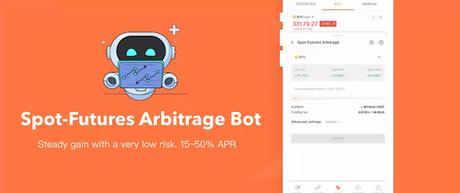
Even though token values nowadays are sliding faster than Bambi on Ice, markets have been difficult recently, and investors are looking for the safest ways to generate passive income in crypto. And I discovered it: a method that doesn't care if Bitcoin is up 50% or down 20%.
Spot Futures Arbitrage bots are what they're called. Don't be frightened if this seems intimidating. I guarantee you'll have an AHA! a moment in the next few minutes. Until then, consider these bots to be automatic fee collectors that don't care if the market is up or what Elon is posting.
But that begs the question, how does it work? What are Spot Futures Arbitrage bots and why couldn't they come up with a more catchy name? Let's break this down piece by piece.
What is Arbitrage?
Arbitrage is the practice of buying and selling the same asset in different markets for a profit. A fascinating example is Sam Bankman-Fried, the 29 year old worth $22 billion. He made a huge chunk of money in crypto early through crypto arbitrage.
He noticed that due to demand for Bitcoin in Korea, prices of a single Bitcoin could trade for as much as 50% higher than US prices. This meant he could buy a Bitcoin for $10,000 in the US and offload it for $15,000 in Korea.
But this had issues, regulations were tight and it was hard to offload a ton of money. So he eventually moved over to Japan. Japan had a lower premium at only 15%, but he could move much more money. So he eventually moved over to Japan. Japan had a lower premium at only 15%, but he could move much more money.
This resulted in him making "literally 10% per weekday, which is absolutely insane." So in summary, arbitrage is profiting off of price differences of the same asset, but the whole title is Spot Futures Arbitrage bots.
So what are Spot Futures Arbitrage bots in this context?
In this case, it refers to the markets you are invested in through this bot. When investing in one of these bots, you are actually buying two different assets, a spot position, and a futures position. The spot position is no different than a regular old buy.
If you flat out bought $100 in Bitcoin, this would be a spot position, also referred to as a long position. A futures position, on the other hand, is a bet on the future price of an asset. A future position can be long or short.
A long futures position is similar to a spot position in that you're betting that prices will go up in the future. A short position is a bet that prices will go down. You make money if the price decreases in a short position. A purchase into one of these bots splits the buy between spot and short in the market. And this has a fascinating result. It's very hard to lose money when you do this.
So let's say you invested $1,000 into one of these bots. $500 would be similar to a regular buy, a bet that prices will go up. $500 would be short, a bet that prices will go down. The result is your investment dollar amount never changes much, because if prices go up, your long position makes money.
If they go down, your short position makes money, meaning your $1,000 stays right around $1,000. Now you're probably wondering, how is it possible to make any money if you're betting with and against the market at the same time? It sounds like something a crazy person would do, but this is where arbitrage comes in. So let's piece this together.
Spot futures arbitrage bot
We know spot and futures are the types of buys that we're making, betting for and against the market at the same time. We know arbitrage is profiting off of price mismatches. And bot, of course, just means a program that does everything for us so we don't have to sit at the computer and monitor things all day like some kind of a hermit.
So what is arbitrage? Where does the profit actually come from?
Well, this is from something called the Funding Fee, also referred to as the Funding rate. This is a fee paid to holders to help ensure market prices are exactly where they should be. The thing is, traditionally in futures markets, there is an expiration date, meaning you could buy a futures position betting on the future price of an asset.
But that position would eventually expire. Usually, this is done quarterly or monthly. The reason for this is prices can get way off track. Regular buy and sell pressures in the market can make the spot price and the future price of an asset vastly different over time. An expiration date essentially creates a reset button so prices are set back on track.
But this comes with an issue. Investors have to constantly re-up their contracts if they want to stay in those positions. And that's why perpetual contracts were created.
Futures contracts that never expire, but because they never expire, there needed to be a way to keep prices between the regular market and the futures market in line. They need to be right around the same price. It's easiest to think of this as a balancing scale.
You have long positions on one side and short on the other whenever prices decrease too far on one side. A funding fee is kind of sprinkled on top to incentivize investors to move over to that side. And this funding fee can be quite high. You can get as high as 1% daily in large Bull runs.
Here's an example of a funding fee at 0.4% every 8 hours. Meaning if you had $10,000 invested, you would make $120 per day nearly risk-free. And that's because the beauty of these bots is you are market neutral. You don't make or lose money no matter where the market heads, but you still earn that funding fee. Now, 1% daily isn't normal, but it's fairly common to make 15% and up to 50% APR.
Now, spot trade arbitrage bots are very low risk compared to most things in crypto. But that doesn't mean there is zero risk. With the moderate bot, especially, there is about as close to zero risk as you can get. The only thing I can think of is some kind of API issue or bug in code that could cause some problems.
However, this has a very low probability. With aggressive bots, there's slightly more risk because you're taking on leverage. This means there's a small chance of being liquidated if the price of your crypto, for some black swan reason, dropped extremely quickly, and then the bot failed to rebalance the position.
What I like about Pionex, though, is they have an insurance fund. In the case of rare events, Pionex charges 10% of profits for running these bots, but half of that goes to their SAFU fund. Basically, this fund is there in case a cataclysmic event happens.

